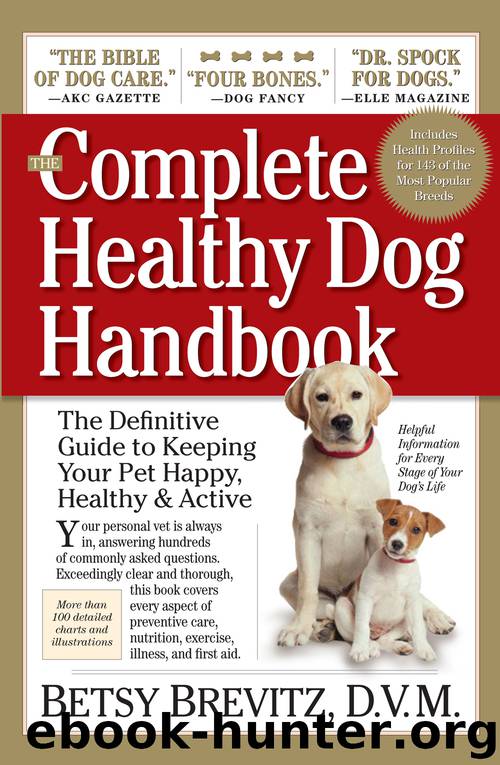The Complete Healthy Dog Handbook by Betsy Brevitz

Author:Betsy Brevitz
Language: eng
Format: epub
Publisher: Workman Publishing Company
Published: 2014-03-14T04:00:00+00:00
CARTILAGE PROBLEMS IN YOUNG DOGS
“My 15-month-old Golden Retriever was limping on a front leg. The vet took x-rays and said my dog has a loose piece of cartilage in his shoulder joint that should be removed. Could he have injured the shoulder without my knowing it?”
The loose cartilage isn’t necessarily the result of an injury. Osteochondrosis dissecans (OCD) is a condition in which cartilage doesn’t form properly in a joint. The cartilage may erode, causing joint pain, and small pieces or flaps of cartilage may break free. OCD is most common in fast-growing, large-breed dogs, such as Rottweilers, Great Danes, Irish Wolfhounds, and Newfoundlands.
A limp and possibly swelling of the joint are the symptoms an owner might notice. Symptoms usually appear between the ages of 6 and 18 months. The shoulder is the joint most commonly affected, followed by the elbow (OCD can be one factor in elbow dysplasia—see page 234), hock, and knee.
Definitively diagnosing OCD can be a challenge, because the defective cartilage is apparent on x-rays only if there are obvious loose fragments, joint swelling, or changes in the underlying bone.
The treatment for OCD is surgery to remove unhealthy cartilage and thereby prevent its ongoing breakdown within the joint. Some degree of arthritis is likely to affect the joint even after surgery, but it will be less severe than if nothing was done. Treatments for arthritis (see page 240) can help relieve the pain of OCD.
Download
This site does not store any files on its server. We only index and link to content provided by other sites. Please contact the content providers to delete copyright contents if any and email us, we'll remove relevant links or contents immediately.
Finding Gobi by Dion Leonard(2779)
Grumpy Cat by Grumpy Cat(2683)
A New Earth: Awakening to Your Life's Purpose by Eckhart Tolle(2595)
The Silkworm by Robert Galbraith(2442)
Tippi by Tippi Hedren(2181)
End of Days by Sylvia Browne(2114)
Total Cat Mojo by Jackson Galaxy(1967)
Backyard Chickens Beyond the Basics by Pam Freeman(1904)
The Animals Among Us by John Bradshaw(1830)
The Ultimate Pet Health Guide by Gary Richter(1726)
All Things Bright and Beautiful by James Herriot(1707)
Vet in Harness by James Herriot(1663)
Doggy Desserts: 125 Homemade Treats for Happy, Healthy Dogs by Cheryl Gianfrancesco(1652)
Dog Years by Mark Doty(1642)
Cesar's Way by Cesar Millan(1632)
Chicken Soup for the Ocean Lover's Soul by Jack Canfield(1600)
Dog Training 101 by Kyra Sundance(1556)
Walking with Peety by Eric O'Grey(1553)
Animal Speak by Ted Andrews(1513)
